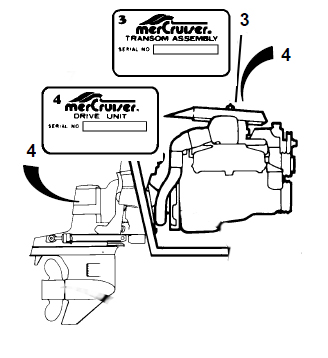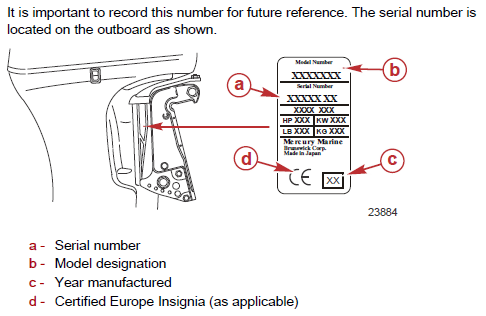Engine manufacturer Mercury Marine makes the Optimax outboard motor in two sizes: 150 horsepower and 135 horsepower. A 150 Optimax Mercury Marine motor relies on a two-stage fuel injection system to deliver power to your boat’s outboard engine. You will need your engine's serial number to repair your Mercury Marine Optimax engine's fuel injection system, belts or motor blades; the serial number is also important if you want to purchase parts and accessories. Rely on three sources to find the serial number for your 150 Optimax Mercury Marine.
- Mercruiser Outdrive Serial Number Location
- 1996 Mercruiser 454 Serial Number Location
- 5.7 Mercruiser Serial Number Location
The Bravo Two outdrive, while physically similar, is not found on engines of greater than 450 horsepower or boats that operate at speeds of greater than 55 mph. For lower-speed or lower-horsepower applications, a Mercury dealer can identify the drive by its serial number. Refer to drawings for engine code location. Information you need from the engine code, example V01177MH. 7=GM’s model year. In this case 1997, but it could also be 1987 or 1977. MH=type of engine. A 350 cid V8, MerCruiser models 5.7L, 350 Mag MPI, Black Scorpion Ski, etc. Re: Mercruiser serial numbers by Bruce » Mon Dec 11, 2017 12:13 pm 46144 are the common engine serial numbers for a 454, 330 model in the year range 77 to 81.


Look on the engine brackets. Mercury Marine notes that it puts each Optimax engine’s serial number and year of manufacture on a sticker on one of the engine’s transom brackets. The transom bracket connects the engine to the rear of your boat, suspending the engine in mid-air behind the boat instead of hanging the engine over the edge of the boat, according to Marine Engine Digest.
Ask a dealer. Mercury Marine dealers can help you find the serial number of your Optimax outboard engine. Check with the dealer who sold you the engine or contact any dealer using Mercury Marine’s directory of dealers. All dealers have product literature and reference materials that can assist you in your search for the engine’s serial number.
Check your owner’s documents. When you purchased your Optimax engine, you should have received a few important owner’s documents that feature the engine’s serial number. Check your owner’s packet for a detailed receipt – which should list the engine serial number – and for an owner’s manual. Optimax manuals feature the engine serial number either on the cover or inside front cover. Java 7 update 40 download 64 bit.
References
About the Author
Matt Browning has been writing about health, science, food and travel since 1990. His career has spanned advocacy, medical communications and public relations and his stories have won awards from the Virginia Press Association. Browning earned a Bachelor of Arts in English language and literature from the University of Virginia.
Mercury produced the Alpha One, Bravo One, Bravo Two, and Bravo Three outdrives beginning in 1972. Later known as the Generation I Alpha One, this outdrive was replaced by the Alpha One Generation II outdrive for the 1984 model year. Production on the 'Gen II' Alpha One continues as of 2011. Because the Alpha One outdrives were limited to relatively low-horsepower applications -- 300 horsepower or less -- Mercury introduced the Bravo series of outdrives in 1986 for engines of up to 600 horsepower and speeds of up to 100 mph.
Alpha One Generation I Outdrive
The Mercruiser Alpha One Generation I outdrive dating from 1972 through 1983 has a square upper gearcase cap with an eye attached to the 4 1/2-by-4 1/2-inch cap. Free download game netbook intel atom. The Alpha One dating from 1984 to 1992 has the same size upper gear case but lacks the lifting eye on top of the gear case cap. The Alpha One Generation I outdrive is limited to engines of 300 horsepower or less.
Alpha One Generation II Outdrive
The Alpha One Generation II upper gear case has a rectangular top cap that's 4 1/2 by 6 1/2 inches, 2 inches larger than the Generation I outdrive. The 'Gen II' Alpha One also does not offer a lifting ring on top of the drive cap. The cap has a lifting notch at the center-rear that does not extend as far across the top cap as the rear bolt holes. Like the Generation I Alpha One outdrive, the Generation II Alpha One is limited to applications of 300 horsepower or less.
Bravo One and Bravo Two
The Bravo One outdrive, for a single engine application, has a lifting notch at the center of the rear of the top cap that extends to the rear bolt holes, almost halfway across the 4 1/2-by-6-inch cover. The Bravo Two outdrive, while physically similar, is not found on engines of greater than 450 horsepower or boats that operate at speeds of greater than 55 mph. Windows 10 build 15025 iso download. For lower-speed or lower-horsepower applications, a Mercury dealer can identify the drive by its serial number.
Mercruiser Outdrive Serial Number Location

Bravo Three Outdrive
1996 Mercruiser 454 Serial Number Location
The Bravo Three outdrive overcomes the tendency of Mercury outdrives to pull the boat to the left. Mercury drives rotate counterclockwise. The torque from this rotation pulls a boat somewhat to port along its course when moving forward. When backing, the torque vigorously pulls the boat to port, even after the engine stops. The Bravo Three outdrive uses a propeller shaft-within-a-shaft driving a twin propeller. The outer propeller shaft turns the propeller nearest the outdrive counterclockwise. The inner propeller shaft -- the shaft-within-a-shaft -- turns the propeller farthest from the outdrive clockwise. These 'counterrotating' propellers cancel out each others' torque to eliminate pull to the left or the right when the boat moves.
References
- Mercruiser Service Manual Number 3A -- Sterndrives; Mercury Marine
- Mercruiser Service Manual Number 11 -- Bravo Sterndrives; Mercury Marine
About the Author
5.7 Mercruiser Serial Number Location
Will Charpentier is a writer who specializes in boating and maritime subjects. A retired ship captain, Charpentier holds a doctorate in applied ocean science and engineering. He is also a certified marine technician and the author of a popular text on writing local history.